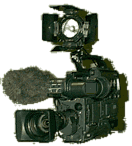Lighting For Video & Television
Video lighting is based on the same principles as lighting for any other visual media. If you haven't done so already, you should read through our general lighting tutorials before reading this page, which deals specifically with lighting issues for video.
Light Sources
All video uses some sort of lighting, whether it be natural light (from the sun) or artificial lights. The goal of video lighting is to choose the best source(s) to achieve your goals.
First and foremost you need enough light. You must ensure that your camera is able to record an acceptable picture in the conditions. With modern cameras this is seldom a problem except in very low light or strong contrast.
Assuming you have enough light, you must then consider the quality of the light and how the various light sources combine to produce the image.
If you have clashing light sources (e.g. artificial interior lights with sunlight coming through the windows), you may find the colours in your image appear unnatural. It's best to control the light sources yourself if possible (e.g. turn off the lights or close the curtains).
When moving between locations, think about what light source you are using. If you move from an outside setting to an inside one with artificial lights, the amount of light may seem the same but the colour temperature will change according to the type of lights. In this case you need to white balance your camera for the new light source.
Contrast Ratio
Contrast ratio is the difference in brightness between the brightest and darkest parts of the picture. Video does not cope with extreme contrast as well as film, and nowhere near as well as the human eye. The result of over-contrast is that some parts of the picture will be too bright or too dark to see any detail. For this reason you need to ensure that there is not too much contrast in your shot. See Camera Contrast Ratio for more details.

Camera-Mounted Lights
The camera-mounted light is an easy, versatile solution used by amateurs and professionals alike. Typically the light will draw power from the camera battery, although a separate power supply can be used. Be aware that lights which draw power from the camera battery will significantly shorten the battery's charge time.
This type of lighting does not create pleasing effects. it is a "blunt instrument" approach which is really only designed to illuminate the scene enough to allow normal camera operations. However it is a simple, practical solution.
Night-Mode Video Shooting
Some cameras offer a special "night vision" option which allows you to shoot with virtually no light. This mode uses infrared light instead of normal visible light.
This is useful in extreme circumstances when you have no other option. Unfortunately the results tend to be poor-quality monochrome green.
Of course, you can use this mode for a special effect if it suits the content.
See Also: Lighting Video Interviews